University Customer Behaviour Analysis for Research Methods (7COM1071)
VerifiedAdded on 2023/04/21
|8
|1045
|496
Homework Assignment
AI Summary
This assignment analyzes customer behavior in an online store, focusing on research methods. The student generates and tests hypotheses related to customer browsing time, spending, navigation errors, and demographic factors. Statistical tests, including t-tests and correlation tests, are used to analyze the data and draw conclusions. The assignment includes SPSS results, a discussion of sampling techniques (stratified random sampling), and an abstract summarizing the findings. It concludes with a proposed methodology for conducting the study, including data collection, cleaning, and analysis, as well as a discussion of the study's limitations and potential future research directions. The analysis uses sample data from 50 customers to examine customer usage behaviour.
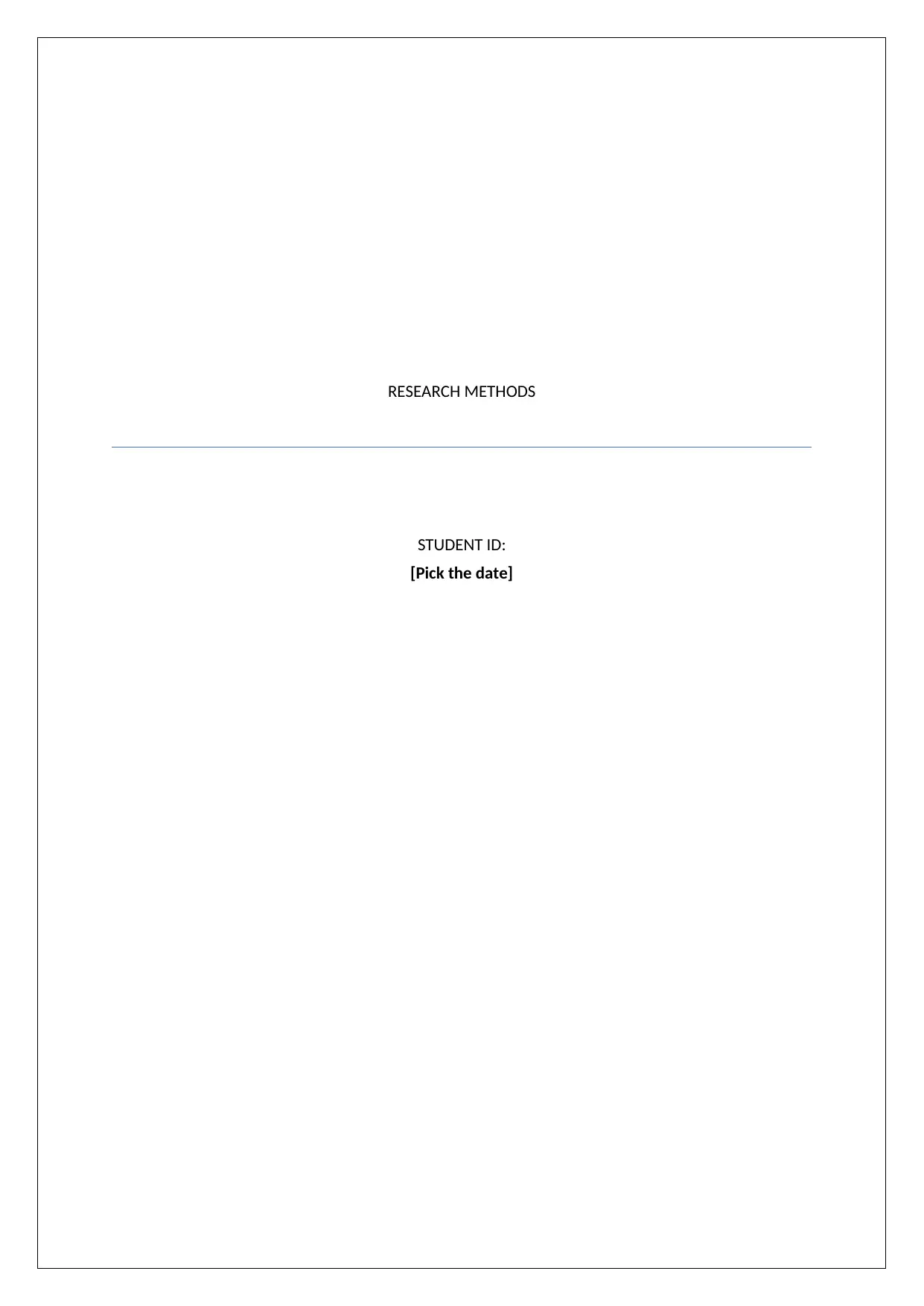
RESEARCH METHODS
STUDENT ID:
[Pick the date]
STUDENT ID:
[Pick the date]
Paraphrase This Document
Need a fresh take? Get an instant paraphrase of this document with our AI Paraphraser
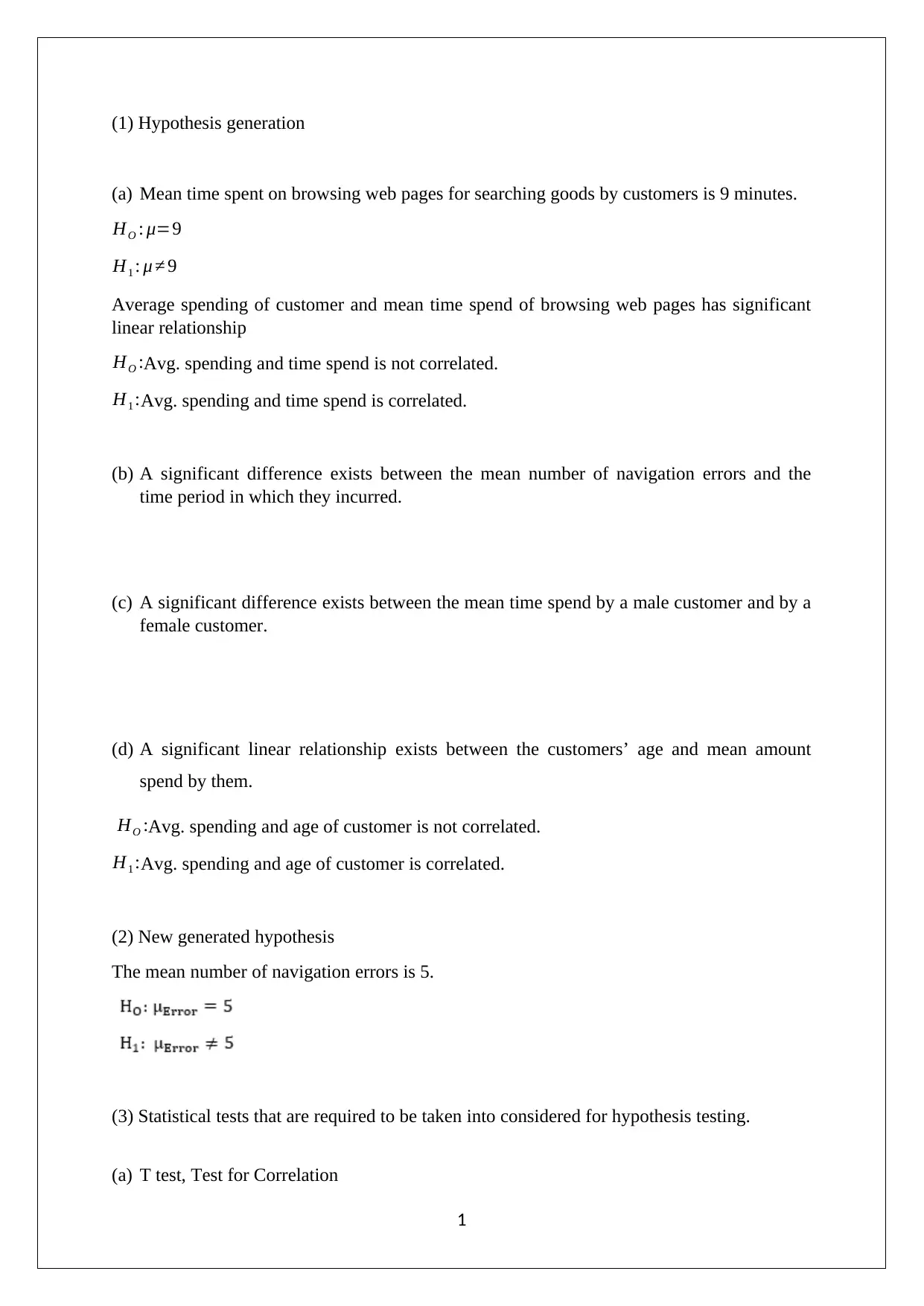
(1) Hypothesis generation
(a) Mean time spent on browsing web pages for searching goods by customers is 9 minutes.
HO : μ=9
H1 : μ ≠ 9
Average spending of customer and mean time spend of browsing web pages has significant
linear relationship
HO :Avg. spending and time spend is not correlated.
H1 :Avg. spending and time spend is correlated.
(b) A significant difference exists between the mean number of navigation errors and the
time period in which they incurred.
(c) A significant difference exists between the mean time spend by a male customer and by a
female customer.
(d) A significant linear relationship exists between the customers’ age and mean amount
spend by them.
HO :Avg. spending and age of customer is not correlated.
H1 :Avg. spending and age of customer is correlated.
(2) New generated hypothesis
The mean number of navigation errors is 5.
(3) Statistical tests that are required to be taken into considered for hypothesis testing.
(a) T test, Test for Correlation
1
(a) Mean time spent on browsing web pages for searching goods by customers is 9 minutes.
HO : μ=9
H1 : μ ≠ 9
Average spending of customer and mean time spend of browsing web pages has significant
linear relationship
HO :Avg. spending and time spend is not correlated.
H1 :Avg. spending and time spend is correlated.
(b) A significant difference exists between the mean number of navigation errors and the
time period in which they incurred.
(c) A significant difference exists between the mean time spend by a male customer and by a
female customer.
(d) A significant linear relationship exists between the customers’ age and mean amount
spend by them.
HO :Avg. spending and age of customer is not correlated.
H1 :Avg. spending and age of customer is correlated.
(2) New generated hypothesis
The mean number of navigation errors is 5.
(3) Statistical tests that are required to be taken into considered for hypothesis testing.
(a) T test, Test for Correlation
1
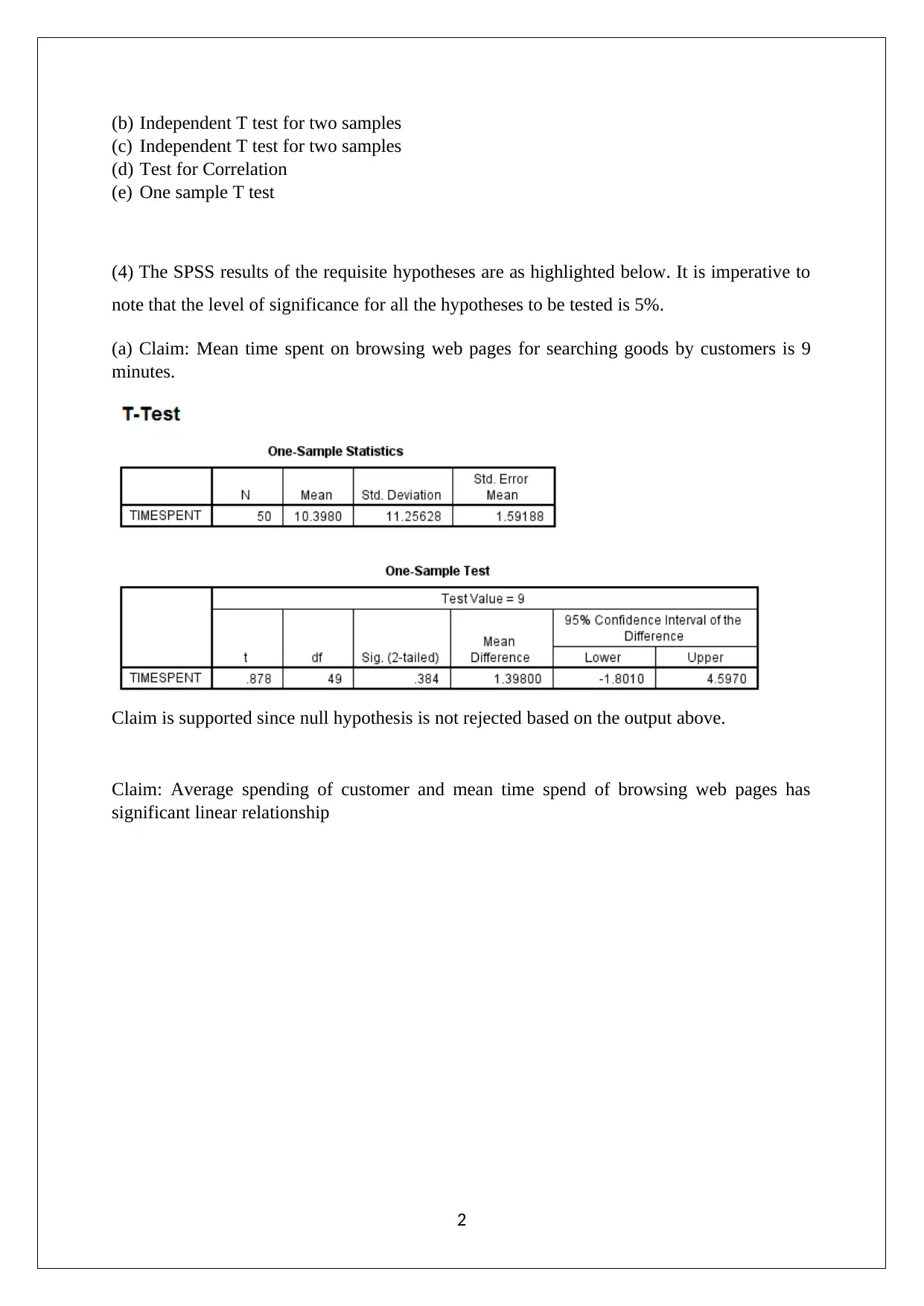
(b) Independent T test for two samples
(c) Independent T test for two samples
(d) Test for Correlation
(e) One sample T test
(4) The SPSS results of the requisite hypotheses are as highlighted below. It is imperative to
note that the level of significance for all the hypotheses to be tested is 5%.
(a) Claim: Mean time spent on browsing web pages for searching goods by customers is 9
minutes.
Claim is supported since null hypothesis is not rejected based on the output above.
Claim: Average spending of customer and mean time spend of browsing web pages has
significant linear relationship
2
(c) Independent T test for two samples
(d) Test for Correlation
(e) One sample T test
(4) The SPSS results of the requisite hypotheses are as highlighted below. It is imperative to
note that the level of significance for all the hypotheses to be tested is 5%.
(a) Claim: Mean time spent on browsing web pages for searching goods by customers is 9
minutes.
Claim is supported since null hypothesis is not rejected based on the output above.
Claim: Average spending of customer and mean time spend of browsing web pages has
significant linear relationship
2
⊘ This is a preview!⊘
Do you want full access?
Subscribe today to unlock all pages.

Trusted by 1+ million students worldwide
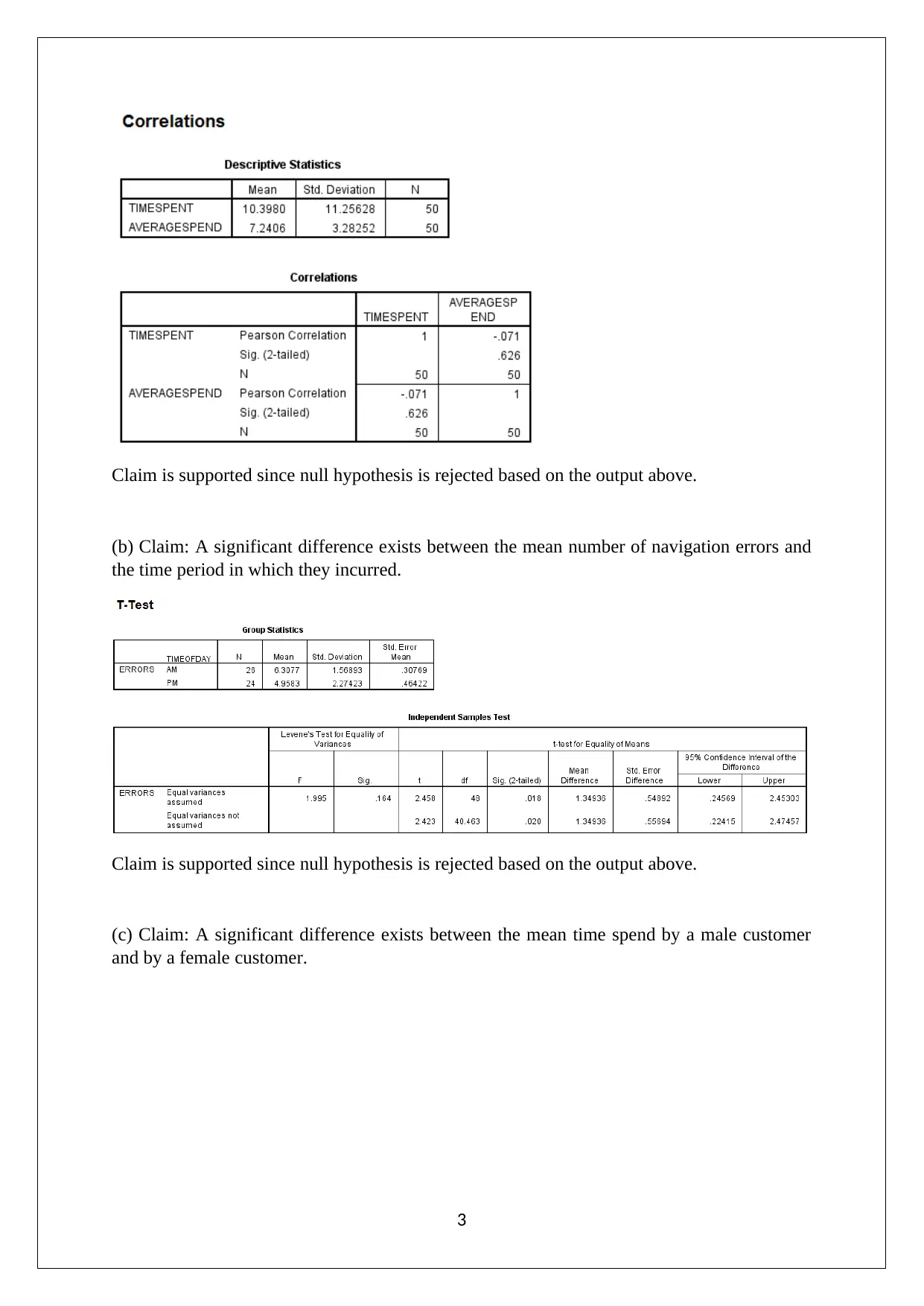
Claim is supported since null hypothesis is rejected based on the output above.
(b) Claim: A significant difference exists between the mean number of navigation errors and
the time period in which they incurred.
Claim is supported since null hypothesis is rejected based on the output above.
(c) Claim: A significant difference exists between the mean time spend by a male customer
and by a female customer.
3
(b) Claim: A significant difference exists between the mean number of navigation errors and
the time period in which they incurred.
Claim is supported since null hypothesis is rejected based on the output above.
(c) Claim: A significant difference exists between the mean time spend by a male customer
and by a female customer.
3
Paraphrase This Document
Need a fresh take? Get an instant paraphrase of this document with our AI Paraphraser
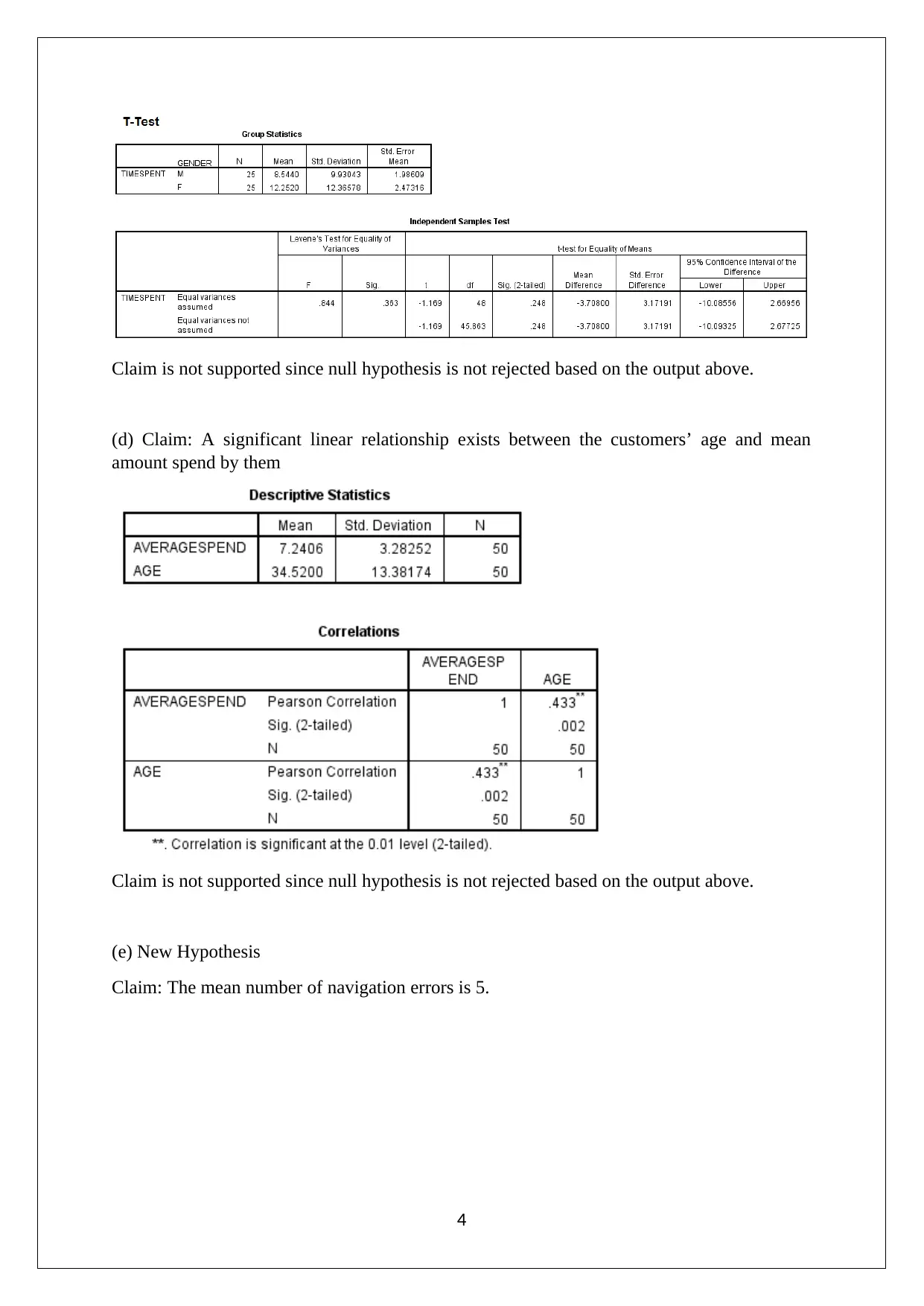
Claim is not supported since null hypothesis is not rejected based on the output above.
(d) Claim: A significant linear relationship exists between the customers’ age and mean
amount spend by them
Claim is not supported since null hypothesis is not rejected based on the output above.
(e) New Hypothesis
Claim: The mean number of navigation errors is 5.
4
(d) Claim: A significant linear relationship exists between the customers’ age and mean
amount spend by them
Claim is not supported since null hypothesis is not rejected based on the output above.
(e) New Hypothesis
Claim: The mean number of navigation errors is 5.
4
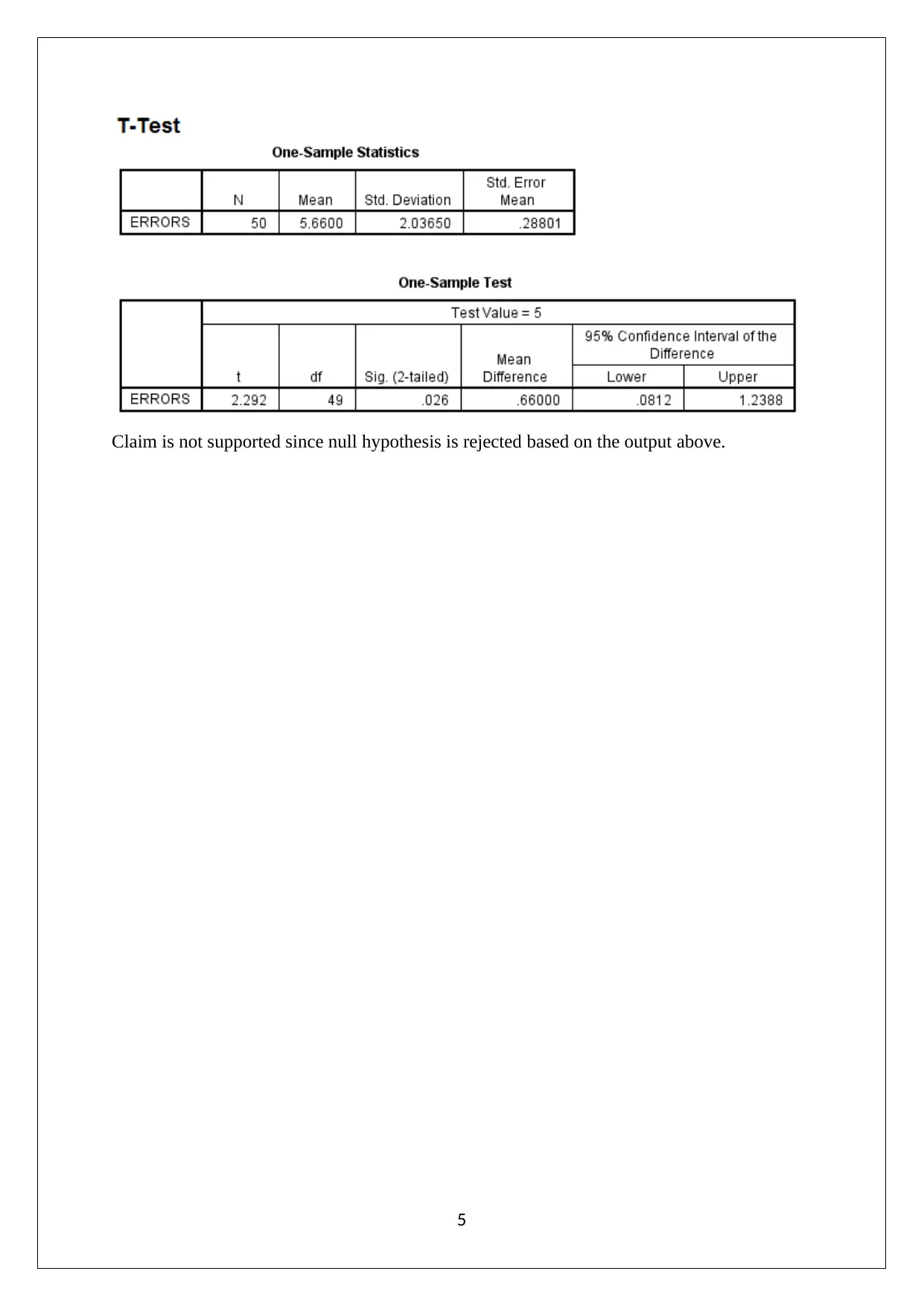
Claim is not supported since null hypothesis is rejected based on the output above.
5
5
⊘ This is a preview!⊘
Do you want full access?
Subscribe today to unlock all pages.

Trusted by 1+ million students worldwide
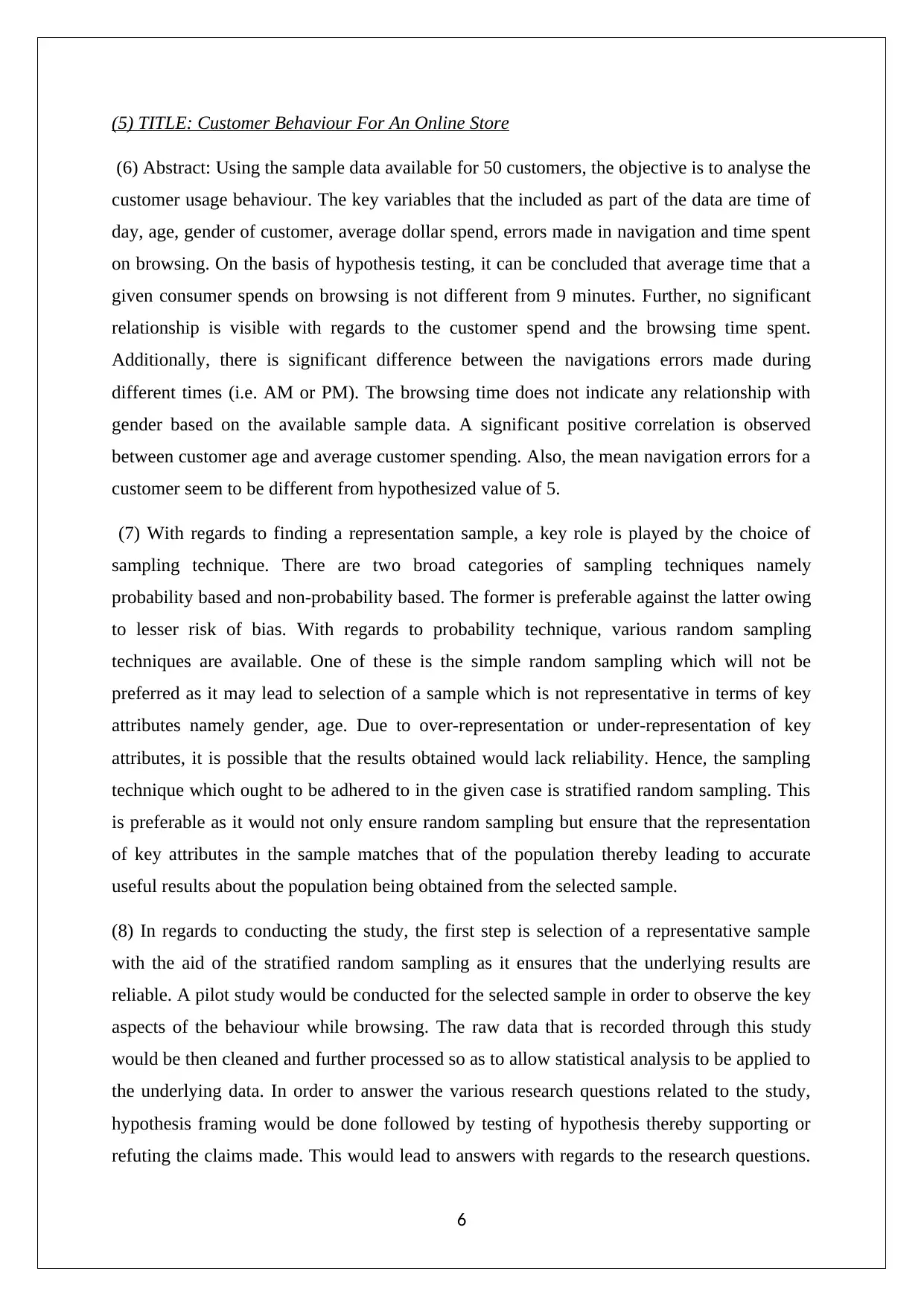
(5) TITLE: Customer Behaviour For An Online Store
(6) Abstract: Using the sample data available for 50 customers, the objective is to analyse the
customer usage behaviour. The key variables that the included as part of the data are time of
day, age, gender of customer, average dollar spend, errors made in navigation and time spent
on browsing. On the basis of hypothesis testing, it can be concluded that average time that a
given consumer spends on browsing is not different from 9 minutes. Further, no significant
relationship is visible with regards to the customer spend and the browsing time spent.
Additionally, there is significant difference between the navigations errors made during
different times (i.e. AM or PM). The browsing time does not indicate any relationship with
gender based on the available sample data. A significant positive correlation is observed
between customer age and average customer spending. Also, the mean navigation errors for a
customer seem to be different from hypothesized value of 5.
(7) With regards to finding a representation sample, a key role is played by the choice of
sampling technique. There are two broad categories of sampling techniques namely
probability based and non-probability based. The former is preferable against the latter owing
to lesser risk of bias. With regards to probability technique, various random sampling
techniques are available. One of these is the simple random sampling which will not be
preferred as it may lead to selection of a sample which is not representative in terms of key
attributes namely gender, age. Due to over-representation or under-representation of key
attributes, it is possible that the results obtained would lack reliability. Hence, the sampling
technique which ought to be adhered to in the given case is stratified random sampling. This
is preferable as it would not only ensure random sampling but ensure that the representation
of key attributes in the sample matches that of the population thereby leading to accurate
useful results about the population being obtained from the selected sample.
(8) In regards to conducting the study, the first step is selection of a representative sample
with the aid of the stratified random sampling as it ensures that the underlying results are
reliable. A pilot study would be conducted for the selected sample in order to observe the key
aspects of the behaviour while browsing. The raw data that is recorded through this study
would be then cleaned and further processed so as to allow statistical analysis to be applied to
the underlying data. In order to answer the various research questions related to the study,
hypothesis framing would be done followed by testing of hypothesis thereby supporting or
refuting the claims made. This would lead to answers with regards to the research questions.
6
(6) Abstract: Using the sample data available for 50 customers, the objective is to analyse the
customer usage behaviour. The key variables that the included as part of the data are time of
day, age, gender of customer, average dollar spend, errors made in navigation and time spent
on browsing. On the basis of hypothesis testing, it can be concluded that average time that a
given consumer spends on browsing is not different from 9 minutes. Further, no significant
relationship is visible with regards to the customer spend and the browsing time spent.
Additionally, there is significant difference between the navigations errors made during
different times (i.e. AM or PM). The browsing time does not indicate any relationship with
gender based on the available sample data. A significant positive correlation is observed
between customer age and average customer spending. Also, the mean navigation errors for a
customer seem to be different from hypothesized value of 5.
(7) With regards to finding a representation sample, a key role is played by the choice of
sampling technique. There are two broad categories of sampling techniques namely
probability based and non-probability based. The former is preferable against the latter owing
to lesser risk of bias. With regards to probability technique, various random sampling
techniques are available. One of these is the simple random sampling which will not be
preferred as it may lead to selection of a sample which is not representative in terms of key
attributes namely gender, age. Due to over-representation or under-representation of key
attributes, it is possible that the results obtained would lack reliability. Hence, the sampling
technique which ought to be adhered to in the given case is stratified random sampling. This
is preferable as it would not only ensure random sampling but ensure that the representation
of key attributes in the sample matches that of the population thereby leading to accurate
useful results about the population being obtained from the selected sample.
(8) In regards to conducting the study, the first step is selection of a representative sample
with the aid of the stratified random sampling as it ensures that the underlying results are
reliable. A pilot study would be conducted for the selected sample in order to observe the key
aspects of the behaviour while browsing. The raw data that is recorded through this study
would be then cleaned and further processed so as to allow statistical analysis to be applied to
the underlying data. In order to answer the various research questions related to the study,
hypothesis framing would be done followed by testing of hypothesis thereby supporting or
refuting the claims made. This would lead to answers with regards to the research questions.
6
Paraphrase This Document
Need a fresh take? Get an instant paraphrase of this document with our AI Paraphraser
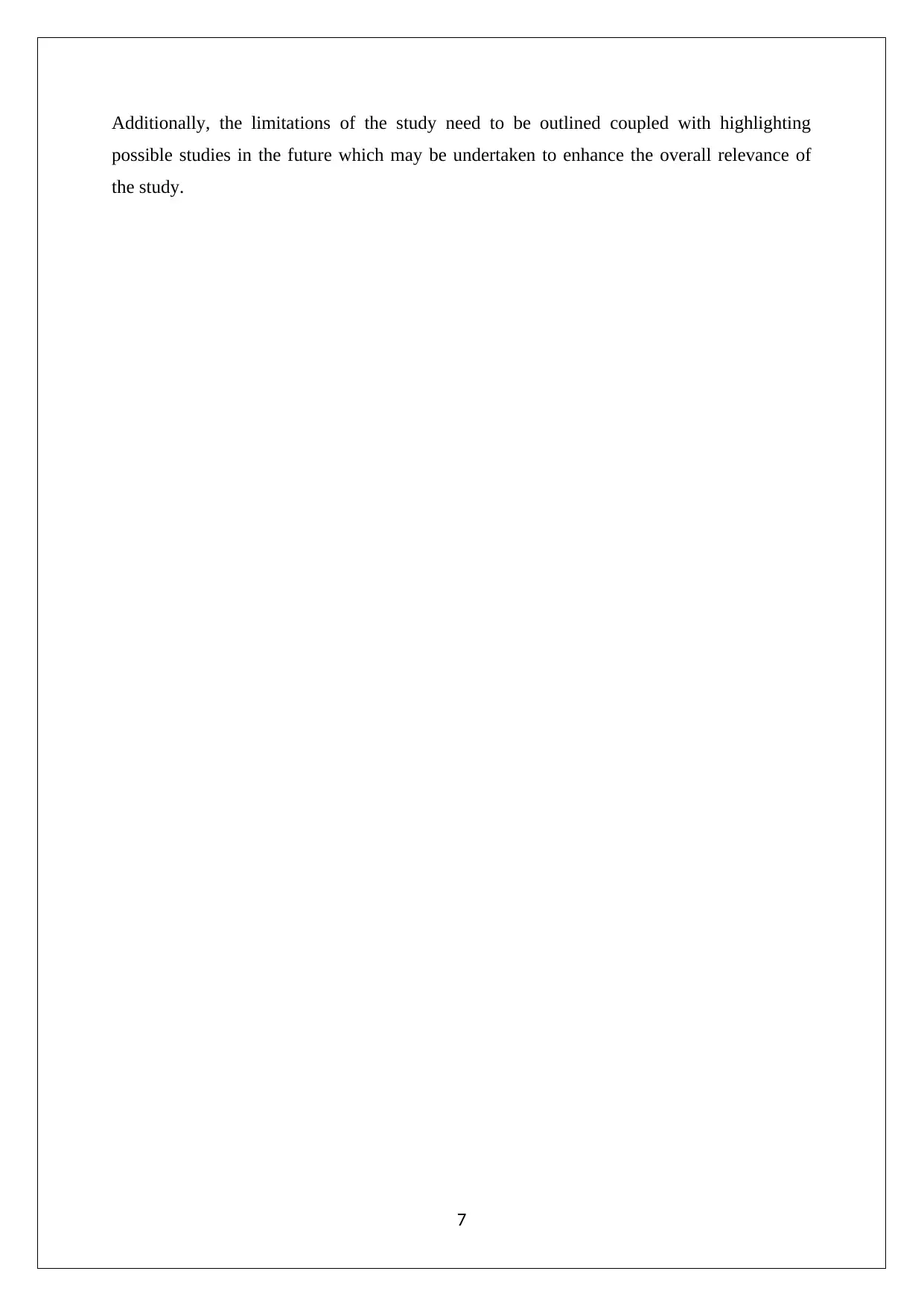
Additionally, the limitations of the study need to be outlined coupled with highlighting
possible studies in the future which may be undertaken to enhance the overall relevance of
the study.
7
possible studies in the future which may be undertaken to enhance the overall relevance of
the study.
7
1 out of 8
Related Documents
Your All-in-One AI-Powered Toolkit for Academic Success.
+13062052269
info@desklib.com
Available 24*7 on WhatsApp / Email
![[object Object]](/_next/static/media/star-bottom.7253800d.svg)
Unlock your academic potential
Copyright © 2020–2025 A2Z Services. All Rights Reserved. Developed and managed by ZUCOL.





